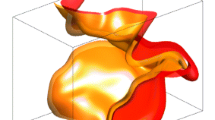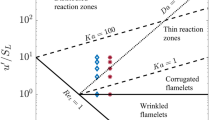Abstract
Precise evaluation of flame surface area plays a pivotal role in the fundamental understanding and accurate modelling of turbulent premixed flames. This necessity is reflected in the requirement for the instantaneous flame area evaluation of the turbulent burning velocity (by making use of Damköhler’s first hypothesis). Moreover, the information regarding flame area is required in the context of flame surface density based modelling, and for determining the wrinkling factor or estimating the efficiency function. Usually flame surface areas in experiments and Direct Numerical Simulation (DNS) analyses are evaluated differently and the present analysis aims at comparing these approaches by making use of a detailed chemistry DNS database of turbulent, statistically planar flames. It has been found that the flame surface area evaluation is sensitive to the choice of scalar quantity and the isosurface level, and this holds particularly true for two-dimensional evaluations. The conditions, which provide a satisfactory agreement between experimental and numerical approaches in the flame area evaluation, have been identified by a detailed comparative analysis of the usual postprocessing techniques.









Similar content being viewed by others
References
Peters, N.: Turbulent Combustion. Cambridge University Press (2000)
Poinsot T. and Veynante D., Theoretical and Numerical Combustion, R T Edwards, (2005)
Creta, F., Matalon, M.: Propagation of wrinkled turbulent flames in the context of hydrodynamic theory. J. Fluid Mech. 680, 225–264 (2011)
Fogla, N., Creta, F., Matalon, M.: The turbulent flame speed for low-to-moderate turbulence intensities: hydrodynamic theory vs. experiments. Combustion and Flame. 175, 155–169 (2017)
Boger, M., Veynante, D., Boughanem, H., Trouvé, A.: Direct numerical simulation analysis of flame surface density concept for large eddy simulation of turbulent premixed combustion. Proc. Combust. Inst. 27, 917–925 (1998)
Driscoll, J.F.: Turbulent premixed combustion: Flamelet structure and its effect on turbulent burning velocities. Prog. Energy Combust. Sci. 34, 91–134 (2008)
Chakraborty, N., Alwazzan, D., Klein, M., Cant, R.S., On the validity of Damköhler’s first hypothesis in turbulent Bunsen burner flames: A computational analysis, Proc. Combust. Inst., 37 (2018)
Hawkes, E.R., and Cant, R.S., Implications of a flame surface density approach to large eddy simulation of premixed turbulent combustion. Combust. Flame, 126(3), 1617–1629. 590 https://doi.org/10.1016/S0010-2180(01)00273-5, (2001)
Nivarti G., Cant S., Direct Numerical Simulation of the bending effect in turbulent premixed flames. Proc. Combust. Inst., 36. 1903–1910, (2017)
Ahmed, U., Chakraborty, N. and Klein, M., Insights into the Bending Effect in Premixed Turbulent Combustion Using the Flame Surface Density Transport, Combust. Sci. Technol., accepted, (2019)
Gülder, O.: Contribution of small scale turbulence to burning velocity of flamelets in the thin reaction zone regime. Proc. Combust. Inst. 31, 1369–1375 (2007)
Sabelnikov, V.A., Yu, R., Lipatnikov, A.N.: Thin reaction zones in constant-density turbulent flows at low Damköhler numbers: theory and simulations. Phys. Fluids. 31, 055104 (2019)
Hult, J., Gashi, S., Chakraborty, N., Klein, M., Jenkins, K.W., Cant, S., Kaminski, C.: Measurement of flame surface density for turbulent premixed flames using PLIF and DNS. Proc. Combust. Inst. 31, 1319–1326 (2007)
Pope, S.B.: The evolution of surfaces in turbulence. Int. J. Eng. Sci. 26, 445–469 (1988)
Im, H.G., Arias, P.G., Chaudhuri, S., Uranakara, H.A.: Direct Numerical Simulations of Statistically Stationary Turbulent Premixed Flames, 10th Asia-Pacific Conference on Combustion, Topical Review, July 19–22. Beijing, China (2015)
Burke, M.P., Chaos, M., Ju, Y., Dryer, F.L., Klippenstein, S.J.: Comprehensive H2-O2 kinetic model for high-pressure combustion. I. J. Chem. Kin. 444-472, (2012)
Im, H.G., Chen, J.H.: Preferential diffusion effects on the burning rate of interacting turbulent premixed hydrogen-air flames, combust. Flame. 126, 246 (2002)
Klein, M., Chakraborty, N., Ketterl, S.: A Comparison of Strategies for Direct Numerical Simulation of Turbulence Chemistry Interaction in Generic Planar Turbulent Premixed Flames. Flow Turb, Combust (2017). https://doi.org/10.1007/s10494-017-9843-9
Yoo, C.S., Wang, Y., Trouve, A., Im, H.G.: Characteristic boundary conditions for direct simulations of turbulent counterflow flames. Combust. Theor. Model. 9, 617–646 (2005)
Rogallo, R.S.: Numerical experiments in homogeneous turbulence. NASA Ames Research Center Report No. 81315, (1981)
Passot, T., Pouquet, P.: Numerical simulation of compressible homogeneous flows in the turbulent regime. J. Fluid Mech. 181, 441 (1987)
Chakraborty, N., Wang, L., Klein, M.: Streamline segment statistics of premixed flames with non-unity Lewis numbers. Phys. Rev. E. E89, 033015 (2014)
Chaudhuri, S., Wu, F., Law, C.K.: Scaling of turbulent flame speed for expanding flames with Markstein diffusion considerations. Phys. Rev. E. 88, 033005 (2013)
Chakraborty, N., Klein, M.: Influence of Lewis number on the surface density function transport in the thin reaction zones regime for turbulent premixed flames. Phys. Fluids. 20, 065102 (2008)
Chakraborty, N., Klein, M., Cant, S.: Effects of turbulent Reynolds number on the displacement speed statistics in the thin reaction zones regime of turbulent premixed combustion. J. Comb. 2011, 1–19 (2011). https://doi.org/10.1155/2011/473679
Klein, M., Chakraborty, N., Jenkins, K.W., Cant, R.S.: Effects of initial radius on the propagation of premixed flame kernels in a turbulent environment. Phys. Fluids. 18, 055102 (2006)
Wu, F., Liang, W., Chen, Z., Ju, Y., Chung, K.: Law, uncertainty in stretch extrapolation of laminar flame speed from expanding spherical flames. Proc. Combust. Inst. 35, 663–670 (2015)
Giannakopoulos, G.K., Gatzoulis, A., Frouzakis, C.E., Matalon, M., Tomboulides, A.G.: Consistent definitions of “flame displacement speed” and “Markstein length” for premixed flame propagation, combustion and flame. Combust. Flame. 162, 1249–1264 (2015)
Sandeep, A., Proch, F., Kempf, A.M., Chakraborty, N.: Statistics of strain rates and surface density function in a flame-resolved high-fidelity simulation of a turbulent premixed bluff body burner, Phys. Fluids. 30, 065101 (2018)
Haworth, D.C.: Applications of turbulent combustion modelling, turbulent combustion, lecture series 2003-04, von Karman Institute for Fluid Dynamics. March. 17-21, (2003)
Chakraborty, N., Klein, M.: A priori direct numerical simulation assessment of algebraic flame surface density models for turbulent premixed flames in the context of large eddy simulation. Fluids. 20, 065102 (2008)
Utkarsh, A.: The ParaView Guide: a Parallel Visualization Application, pp. 978–1930934306. Kitware, ISBN (2015)
Pareja, J., Johchi, A., Li, T., Dreizler, A., Böhm, B.: A study of the spatial and temporal evolution of auto-ignition kernels using time-resolved tomographic OH-LIF. Proc. Combust. Inst. 37, 1321–1328 (2019)
Donbar, J.M., Driscoll, J.F., Carter, C.D.: Reaction zone structure in turbulent non-premixed jet flames from CH-OH PLIF images. Combust. Flame. 122, 1–19 (2000)
Jainski, C., Rißmann, M., Böhm, B., Dreizler, A.: Experimental investigation of flame surface density and mean reaction rate during flame–wall interaction. Proc. Combust. Inst. 36, 1827–1834 (2017)
Canny, J.: A computational approach to edge detection. Readings in Computer Vision, Morgan Kaufmann Publishers. 184-203, (1987)
Jainski, C., Rißmann, M., Böhm, B., Janicka, J., Dreizler, A.: Sidewall quenching of atmospheric laminar premixed flames studied by laser-based diagnostics. Combustion and Flame. 183, 271–282 (2017)
Peterson, B., Baum, E., Böhm, B., Dreizler, A.: Early flame propagation in a spark-ignition engine measured with quasi 4D-diagnostics. Proc. Combust. Inst. 35, 3829–3837 (2015)
Hawkes, E.R., Sankaran, R., Chen, J.H.: Estimates of the three-dimensional flame surface density and every term in its transport equation from two-dimensional measurements. Proc. Combust. Inst. 33, 1447–1454 (2011)
Chakraborty, N., Hawkes, E.R.: Determination of 3D flame surface density variables from 2D measurements: validation using direct numerical simulation, Phys. Fluids. 23, 065113 (2011)
Lorensen, W.E., Cline, H.E.: Marching cubes: a high resolution 3D surface construction algorithm. Comput. Graph. 21, 163–169 (1987)
Funding
The authors are grateful to EPSRC, UK, the German Research Foundation (DFG, KL1456/5–1; DFG 237267381 – TRR 150) and competitive research funding from King Abdullah University of Science and Technology (KAUST) for financial support. Computational support by ARCHER, Rocket HPC, KAUST Supercomputing Laboratory is also gratefully acknowledged.
Author information
Authors and Affiliations
Corresponding author
Ethics declarations
Ethics Statement
This work did not involve any active collection of human data.
Competing Interests
We have no competing interests.
Appendix
Appendix
The Software Paraview has been used for postprocessing the isosurfaces based flame surface areas [32]. In this respect, piecewise planar interface reconstructions (more precisely a triangulation) have been employed. The very famous “Marching cube” algorithm [41] has been used in order to calculate the isosurfaces. The evaluation of surface areas for our application has been verified in the following manner: The DNS data fields specified in the paper have been filtered and subsequently sampled on grids coarsened by a factor of 2 and 4 in each direction (denoted as DNS2 and DNS4, respectively). The DNS resolution is used as a reference and the relative errors have been calculated and are reported in the Table 4 below. Results indicate that a sufficiently small error is obtained for all cases. Furthermore, as the grid is coarsened by a factor two and four respectively, it demonstrates nearly quadratic convergence of flame areas with increasing resolution (except for case C).
Rights and permissions
About this article
Cite this article
Klein, M., Herbert, A., Kosaka, H. et al. Evaluation of Flame Area Based on Detailed Chemistry DNS of Premixed Turbulent Hydrogen-Air Flames in Different Regimes of Combustion. Flow Turbulence Combust 104, 403–419 (2020). https://doi.org/10.1007/s10494-019-00068-2
Received:
Accepted:
Published:
Issue Date:
DOI: https://doi.org/10.1007/s10494-019-00068-2




